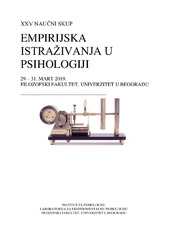| dc.description.abstract | Refugee Health Screener (RHS–13) is a brief screening tool designed to assess most common
symptoms of mental health conditions in refugee population. Despite its indisputable practical
value in mental health screening and psychological triage, there has been little evidence on
basic psychometric properties of this instrument. Therefore, this study aims to explore internal
constancy and factor structure of RHS–13 on a diverse sample of refugees/asylum
seekers/migrants. Sample consisted of 567 refugees/asylum seekers/migrants (86.8% male, age
range 13 – 65 years (M = 23.37, SD = 8.59) from different countries, including Syria,
Afghanistan, Cuba, Nigeria, Iraq, Zimbabwe, etc. RHS–13 consists of 13 Likert-scale items
representing most common psychological distress symptoms in refugee population i.e.
symptoms of anxiety, depression and post-traumatic stress. Results showed good internal
consistency (α = .861). Using the Maximum Likelihood estimation method we te sted the one-
, two – and three-factor models. One-factor model was rather poor χ2(54) = 265.15, p < .001;
CFI = .888; RMSEA = .083 [CI90%: .073 – .095], two-factor model (factor 1: anxiety and
depression symptoms, factor 2: post-traumatic stress symptoms) had better fit χ2(53) = 201.69,
p < .001; CFI = .921; RMSEA = .070 [CI90%: .060 – .081], while three-factor model χ2(51) = 190.17, p < .001; CFI = .926, RMSEA = .069 [CI90%: .059 – .080] had also good fit.
The results show that three-factor model fits best the data (one- vs three-factor model p < .001;
two- vs three-factor model p < .01) indicating a clear factorial structure of RHS-13. Therefore,
our data justify the usage of additional cut-off scores, alongside recommended overall RHS-13
cut-off score, in screening for anxiety, depression and post traumatic stress symptoms in
refugee population. | sr |

